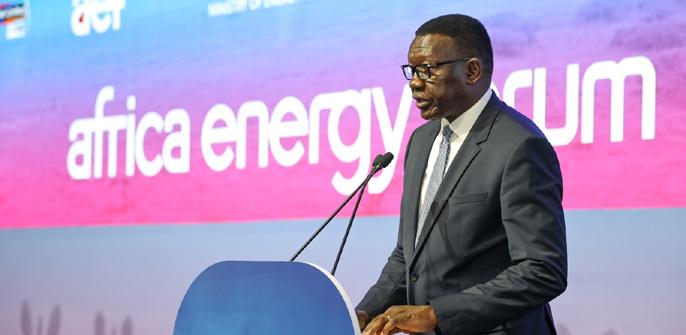
3 minute read
Base Titanium: Australian Firm leading Kenya’s Green Mining sector
from theTradeEnvoy
Kenya has made considerable progress in the sector through strategic partnerships with private investors engaged in exploration and mining.
Base Titanium is among the leading companies in the Kenyan mining market. Since 2013, the Australian firm has been at the helm of operations at the Kwale Mineral Sands Project situated in the Kenyan Coast region. The Mineral Sands are rich in a range of valuable minerals, including Ilmenite, Rutile, and Zircon. According to the company, these minerals form pigments used in manufacturing paints and plastic. Currently, Base Titanium controls 65 percent of Kenya’s mining industry, making it the biggest player in Kenya..
Advertisement
The Mineral Sands project forms part of Kenya’s long-term development blueprint named Vision 2030, which aims at, among other goals, establishing Kenya as an industrial nation by the year 2030.
Beyond drilling and extraction activities, Base Titanium strives to embody an ideal, reciprocal relationship with the local community. The company’s operations prioritize environmental conservation and community welfare improvement.
Environmentally Friendly Operations
Environmental conservation activities are central to operations at the Kwale project, as the company seeks to mitigate environmental degradation. Initiatives include mangrove conservation along the Kwale Coastline and the restoration of previously mined land. Base Titanium maintains the principle that “Mining can be green and environmentally friendly if mining companies minimize surface disturbance and commit to rehabilitating and restoring mined-out land post-mining.”
In partnership with the State Department of Environment, Base Titanium works diligently to protect the environment. The Australian firm has also invested in community programs designed to directly benefit the area residents. These include establishing new schools with quality structures, creating local employment opportunities, and enhancing food security in an otherwise semi-arid region.
Elijah Mwangi Principal Secretary for the Department of Mining

mining plans, as the government looks to capitalize on public-private partnerships to develop more commercially viable projects
Speaking during a visit to the Kwale County-based project on May 5, Principal Secretary for the Department of Mining Elijah Mwangi affirmed the state’s commitment to streamlining operations within the sector as a way of attracting more investors. “We intend to provide policy stability, promote ethical mining practices, restore investors’ confidence, and spur investment in the industry,” stated Mwangi.
Botswana and Namibia

In 2014, Botswana and Namibia signed an agreement to establish a jointly run company that supervised the construction of the TransKalahari Railroad.
The US$ 9.5 billion Trans-Kalahari railway meant to connect Botswana’s Mmamabula coal fields to Walvis Bay in Namibia is, however, yet to commence.

Upon completion, the 1,900km Trans-Kalahari railway is expected to allow the export of up to 65 million tonnes of coal a year from Botswana through Walvis Bay. As a result, this would unlock the value of coal mining in the South African country and power generation in the entire region. It is also expected to provide greater access to global markets for other landlocked countries in the region. These countries include Malawi, Zambia, and Zimbabwe.
Diamonds Are Forever: Opportunities in Botswana
Botswana, known for its rich diamond reserves, has been making strides to solidify its position as a global diamond hub. In 2008, the Diamond Technology Park was established with four areas of focus: diamond cutting and polishing, establishing a rough and polished diamond trading facility, developing diamond jewelry manufacturing, and support industries.
The park was designed to attract diamond technology companies from around the globe. A significant boost to this ambition came in 2016, when the U.S. International Development Finance Corporation (DFC), in partnership with Barclays and Lazare Kaplan, approved a $125 million loan guarantee facility, aimed at stimulating diamond processing in Botswana. A second tranche of the same amount was approved in 2018, in partnership with the Standard Bank Group.
Perhaps one of the most significant developments was the relocation of the De Beers Group’s diamond sorting and sales facility from the United Kingdom to Botswana, a move that further solidifies the country’s position as a key player in the diamond industry.
Perhaps one of the most significant developments was the relocation of the De Beers Group’s diamond sorting and sales facility from the United Kingdom to Botswana, a move that further solidifies the country’s position as a key player in the diamond industry.

In addition to diamonds, Botswana has sought to attract investment in targeted sectors and geographic areas through the establishment of a Special Economic Zones (SEZ) Authority.
Unleashing Potential: The Trans-Kalahari Railroad
Botswana and Namibia took a significant step towards economic integration and trade facilitation in 2014 by agreeing to establish a jointly-run company to supervise the construction of the Trans-Kalahari Railroad. This ambitious $9.5 billion project aims to connect Botswana’s Mmamabula coal fields to Walvis Bay in Namibia, unlocking the potential of the region’s coal reserves.
Although the project has yet to commence, the implications of the 1,900 km Trans-Kalahari railway are enormous. Once completed, it is expected to facilitate the export of up to 65 million tonnes of coal per year from Botswana through Walvis Bay, enhancing the profitability of coal mining in the country and potentially boosting power generation in the entire region.
Furthermore, the Trans-Kalahari railway would provide greater access to global markets for other landlocked countries in the region, such as Malawi, Zambia, and Zimbabwe. This promises to bring unprecedented economic opportunities and growth to these countries, transforming the Southern African economic landscape.










